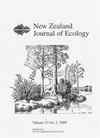The invasion of non-native epiphyte Platycerium bifurcatum in Auckland’s urban forest canopy
IF 1.4
3区 环境科学与生态学
Q3 ECOLOGY
引用次数: 0
Abstract
: New Zealand has been subject to extensive plant introductions since the 1840s leading to c. 2700 naturalised plant taxa including 500 serious environmental weeds. To date, non-native plant invasions in New Zealand have not included epiphytic invasions in forest canopies. Numerous records indicate non-mediated naturalisation of individuals of the non-native epiphytic fern Platycerium bifurcatum have been made; further, recent survey work on urban epiphytes identified a number of juveniles across the Auckland isthmus. To investigate the extent of P. bifurcatum naturalisation across Auckland we identified 30 mature plants of varying sizes that had been planted across the Auckland isthmus on both public and private land using iNaturalist NZ. A further 46 mature plants were identified during field surveys and whilst driving between field sites. All adult plants were measured and all publicly accessible walls and trees for up to 100 m around each plant were checked for juvenile plants. We recorded 104 juvenile (naturally established) plants; all but 19 had at least two publicly accessible adults within 100 m. Platycerium bifurcatum is establishing on trees with fissured or cracked bark-types and on scoria walls. Where large, fertile specimens of P. bifurcatum occur within 100 m, and suitable surfaces are available, this non-native epiphyte is successfully establishing in Auckland’s urban forest canopy. The potential for this non-native epiphyte to spread into native forest ecosystems is not assessed in this study; however, key risks are highlighted along with suggested next steps to monitor and potentially control P. bifurcatum before this fern can invade奥克兰城市森林冠层外来附生植物双歧柏树的入侵
本文章由计算机程序翻译,如有差异,请以英文原文为准。
求助全文
约1分钟内获得全文
求助全文
来源期刊

New Zealand Journal of Ecology
环境科学-生态学
CiteScore
3.00
自引率
12.50%
发文量
35
审稿时长
>36 weeks
期刊介绍:
The New Zealand Journal of Ecology is a biannual peer-reviewed journal publishing ecological research relevant to New Zealand/Aotearoa and the South Pacific. It has been published since 1952 (as a 1952 issue of New Zealand Science Review and as the Proceedings of the New Zealand Ecological Society until 1977). The Journal is published by the New Zealand Ecological Society (Inc.), and is covered by Current Contents/Agriculture, Biology and Environmental Science, GEOBASE, and Geo Abstracts.
 求助内容:
求助内容: 应助结果提醒方式:
应助结果提醒方式:


